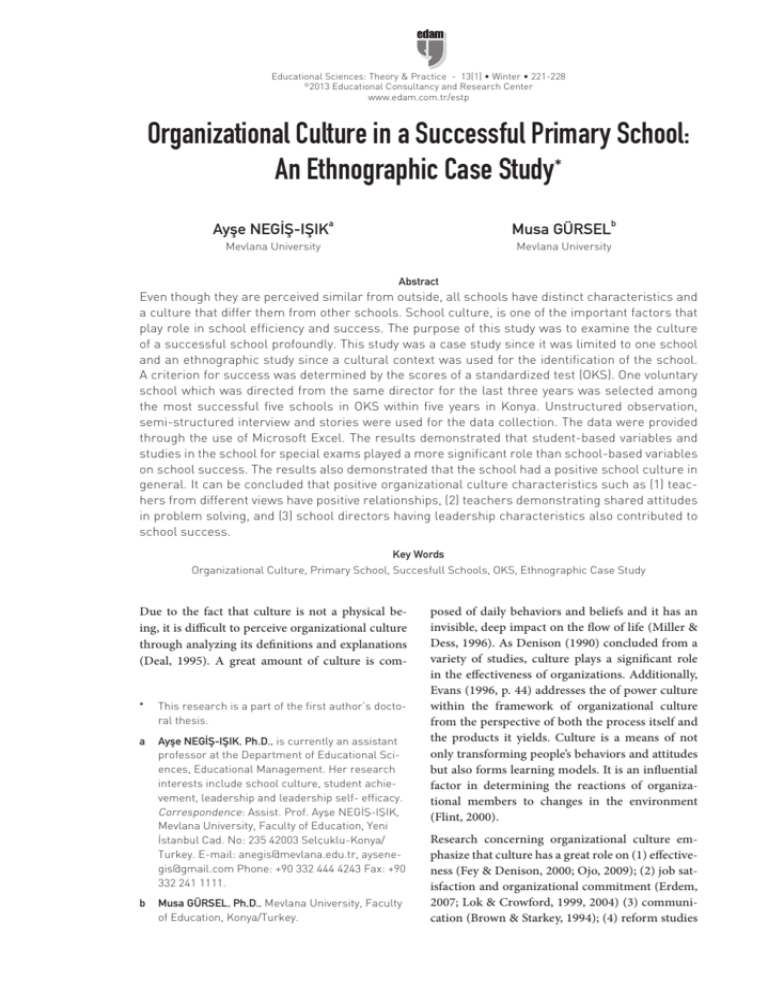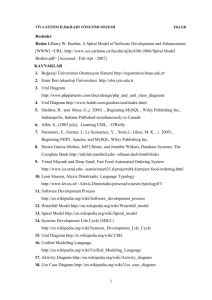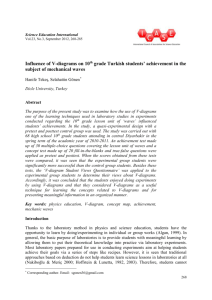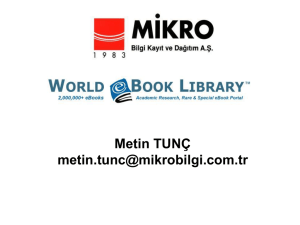Organizational Culture in a Successful Primary School
advertisement

Educational Sciences: Theory & Practice - 13(1) • Winter • 221-228 © 2013 Educational Consultancy and Research Center www.edam.com.tr/estp Organizational Culture in a Successful Primary School: An Ethnographic Case Study* a b Ayşe NEGİŞ-IŞIK Musa GÜRSEL Mevlana University Mevlana University Abstract Even though they are perceived similar from outside, all schools have distinct characteristics and a culture that differ them from other schools. School culture, is one of the important factors that play role in school efficiency and success. The purpose of this study was to examine the culture of a successful school profoundly. This study was a case study since it was limited to one school and an ethnographic study since a cultural context was used for the identification of the school. A criterion for success was determined by the scores of a standardized test (OKS). One voluntary school which was directed from the same director for the last three years was selected among the most successful five schools in OKS within five years in Konya. Unstructured observation, semi-structured interview and stories were used for the data collection. The data were provided through the use of Microsoft Excel. The results demonstrated that student-based variables and studies in the school for special exams played a more significant role than school-based variables on school success. The results also demonstrated that the school had a positive school culture in general. It can be concluded that positive organizational culture characteristics such as (1) teachers from different views have positive relationships, (2) teachers demonstrating shared attitudes in problem solving, and (3) school directors having leadership characteristics also contributed to school success. Key Words Organizational Culture, Primary School, Succesfull Schools, OKS, Ethnographic Case Study Due to the fact that culture is not a physical being, it is difficult to perceive organizational culture through analyzing its definitions and explanations (Deal, 1995). A great amount of culture is com- * This research is a part of the first author’s doctoral thesis. a Ayşe NEGİŞ-IŞIK, Ph.D., is currently an assistant professor at the Department of Educational Sciences, Educational Management. Her research interests include school culture, student achievement, leadership and leadership self- efficacy. Correspondence: Assist. Prof. Ayşe NEGİŞ-IŞIK, Mevlana University, Faculty of Education, Yeni İstanbul Cad. No: 235 42003 Selçuklu-Konya/ Turkey. E-mail: anegis@mevlana.edu.tr, aysenegis@gmail.com Phone: +90 332 444 4243 Fax: +90 332 241 1111. b Musa GÜRSEL, Ph,D., Mevlana University, Faculty of Education, Konya/Turkey. posed of daily behaviors and beliefs and it has an invisible, deep impact on the flow of life (Miller & Dess, 1996). As Denison (1990) concluded from a variety of studies, culture plays a significant role in the effectiveness of organizations. Additionally, Evans (1996, p. 44) addresses the of power culture within the framework of organizational culture from the perspective of both the process itself and the products it yields. Culture is a means of not only transforming people’s behaviors and attitudes but also forms learning models. It is an influential factor in determining the reactions of organizational members to changes in the environment (Flint, 2000). Research concerning organizational culture emphasize that culture has a great role on (1) effectiveness (Fey & Denison, 2000; Ojo, 2009); (2) job satisfaction and organizational commitment (Erdem, 2007; Lok & Crowford, 1999, 2004) (3) communication (Brown & Starkey, 1994); (4) reform studies EDUCATIONAL SCIENCES: THEORY & PRACTICE (Leitwood, Jantzi, & Fernandez, 1994) and (5) organizational quality of life (Argon & Kösterelioğlu, 2009). The findings of the organizational research encourage educational researchers to utilize fundamental cultural elements of the successful schools. All the schools have either strong or weak and functional or nonfunctional cultural elements (Cunningham & Gresso, 1993; Ramsey, 1992). School culture is defined as a body of unrecorded (Peterson & Deal, 2002), transmitted norms, values, beliefs, traditions, and mythical meaning patterns employed by organizational members (Çelik, 2009, p. 32; Stolp & Smith, 1995, p. 13). It can be concluded that organizational culture has a key role in specifying the school’s effectiveness and achievement (Goldring, 2002; Gomez, Marcoulides, & Heck, 2012; Westhuizen, Mosoge, Swanepoel, & Coetsee, 2005). Moreover, there are many studies revealing the relationship between school culture and academic aspiration, (McCollum & Yader, 2011), academic achievement (Şahin, 2011), teacher job satisfaction (Hatchett, 2010), and organizational commitment (Karadağ, Baloğlu, & Çakır, 2011). The significant role of culture in achievement led to studies focusing specifically on the characteristics of the school culture in academically successful schools (Benton, 1999; Kenner, 2000; Nericcio, 1994; Onoye, 2004; Shaw, 1990; Smith, 2006). Several researchers found out common features of such schools. They are; (1) schools with a communicatively accessible atmosphere and where the members are cooperative and committed to their job (Benton, 1999; Eubanks, 1994; Lima, 2006; Mitchell & Willower, 1992; Onoye; Sergiovanni, 1994); (2) schools where teachers are included in the decision-making process (Kenner; Mitchell & Willower); (3) schools with a strong academic focus (Benton; Maehr & Braskamp, 1986; Onoye); and (4) schools where administrators have leadership abilities (Onoye). The national literature studies on school culture dominantly used quantitative methods and aimed to reveal whether school culture displays positive or negative cultural characteristics (Arslan, Satıcı, & Kuru, 2007; Aslan, Özer, & Ağıroğlu Bakır, 2009; Ayık & Ada, 2009; Fırat, 2007; Gedikoğlu & Tahaoğlu, 2010; Gezer, 2005; Korkmaz, 2008; Sönmez, 2006; Şahin, 2004; Terzi, 2005; Yavuz, 2012; Yılmaz & Oğuz, 2005). Academic achievement can be defined as the level of attainment of goals (Buluş, Duru, Balkız, & Duru, 2011) or consistency between goals and 222 behaviors (Bloom, 1998). Educational goals are grouped in three categories as; (1) Long-term goals (Country’s educational policies and philosophies), (2) General goals (the main framework of people to be educated e.g. Adoption of cultural values), (3) Specific objectives (the objectives of the discipline or course) (Demirel, 2010, p. 106). The academic achievement of a school can be outlined as the attainment of all intended outcomes. Nevertheless, school success is generally considered from the perspective of specific objectives with their difficulty in measurement and evaluation. In this study, student academic achievement is taken into consideration as a criterion to identify school achievement. Academic achievement can be regarded as the grades or the average of grades taken from an academic course (Özgüven, 1998). As a result, grades can be an indicator of academic achievement of the students via measurement and evaluation of the course teacher. It is of great significance that, it is not possible to draw common conclusions by taking different measurement and evaluation tools into account. Therefore, in this study, school achievement is limited to student academic achievement in the courses which constitute the courses in the OKS (Secondary Education Placement Examination). In this study, it was aimed to describe the culture in an academically successful primary school in Konya in a detailed way. Within this scope, the study seeks to find the answers to the following research questions: 1. What are the characteristics of the school culture? 2. What are the opinions of the participants concerning the source of school achievement? Method Research Design In this study, qualitative research design was used to analyze school culture. According to Merriam (1998, p. 14), a study which focuses on school culture, a group of students or behaviors in the classroom should use ethnographic case study format. A case study provides the researcher with real life events in a meaningful and holistic way when the case is not distinctive in its context (Yin, 1993, p. 3, 2003, p. 2). Ethnography is frequently used by the anthropologists to explore communities of people and their culture. Ethnography as a body of methods analyses a specific culture from the viewpoints NEGİŞ-IŞIK, GÜRSEL / Organizational Culture in a Successful Primary School: An Ethnographic Case Study of its members (Hammersley & Atkinson, 1995, p.1, Hatch, 2002, p. 21). This study is both a case study since its scope is limited to one school and an ethnographic study owing to the fact that it strives to make a description of the particular school through using a cultural content. The Selection of the School The study group is assigned according to criterion sampling. In this study, three criteria are taken into account in school selection. They are; (1) OKS success rank order of the last five years; (2) school principal’s tenure-(3 years minimum); (3) school’s being voluntary to participate in the study Data Collection Tools Data were collected via unstructured observation and semi-structured interview and stories. Unstructured Observation: In this study suggestions from Merriam (1998), Schein (1997) and similar studies (Sarı, 2007) were considered and unstructured observation was preferred. Within the study, in line with Merriam (p. 97-98) suggestions, (a) physical setting of the school, (b) participants, (c) activities and interpersonal interaction (d) conversations in the environment, (e) observer and (f) informal activities and non-verbal communication were observed in the school environment. Semi-structured Interview: Semi-structured interview was used to benefit from both the advantage of fixed responses in structured interview and the flexibility of unstructured interview in the relevant field (Büyüköztürk, Çakmak, Akgün, Karadeniz, & Demirel, 2008, p. 234). During the preparation stage of the interview form, theoretical explanations on school culture, sub-dimensions of school culture, unstructured observation made by the researcher and stories transmitted by the teachers were taken into account. Stories Telling stories is one of the oldest traditions in all the cultures of the world (Mears, 2008, p. 407). Social actors use stories to tell significant events and personal experiences of their lives. Cultural heritage and organizational culture are transferred by means of stories and their heroes repeatedly (Coffey & Atkinson, 1996, p. 56). In this study, organizational stories were used as a tool to collect data in order to describe organizational culture. During data collection, forms were prepared by the researchers to be filled by the teachers and the administrators to reflect personal experiences which affected them in a positive or negative way. Validity and Reliability For the validity and reliability of the study, coding coherence was checked and it was calculated as .87. In addition, member checking and long term interaction techniques were used for detailed description to ensure transferability (Stake, 1995, p. 145). Data Analysis In qualitative analysis, researchers have to analyze a great amount of data (Miles, 1979). In this study, 34 stories, 98 pages of interviews collected from 13 participants and 30 pages of observation notes were examined. A content analysis was carried on stories, observations and data collected from the interviews together with the subsequent data. Microsoft Excel was used to analyze the interviews and the observation notes in a systematic way parallel to the suggestions of the researchers (Meyer & Avery, 2009). Microsoft Excel was preferred due to its being applicable in providing the researcher with the opportunity to classify and display data which have common codes (Nergiş Işık, 2010). Results In this part, the findings of the study are given. Primarily, a brief overview on the history of school and its general characteristics are provided. Secondly, stories gathered from teachers and school administrators are analyzed. Finally, all data collected during the course of the study were classified taking the research questions into account. Findings Collected from the Stories Stories were grouped in 7 general topics. They are; (1) relations with parents, (2) sacrifice, (3) achievement (4) relations with teachers, (5) administration, (6) relations with students and (7) special occasions. It was observed that 65 % of the stories taken from teachers and administrators are positive and 35 % are negative. A great majority of the negative stories are concerned with the parents and relations with the administration (11 stories out of 12). 223 EDUCATIONAL SCIENCES: THEORY & PRACTICE The School’s Past and Present The school went through a number of transformations. The first of transformation was when there was a small number of student and teacher population. It can be said that the school administration and teachers work collaboratively to increase academic success in examinations. The academic success made both the teachers and the administrators popular in the educational environment which led to the second transformation. Moreover, there was a dramatic increase in the number of students and teachers and there has been a shift in the administrative role of the school principal recently, which resulted in a loss in the spirit of collaboration in the school. Problems/Solutions to Problems The most frequently encountered problems in the school are (1) parents’ interference in administrative issues and (2) unsuccessful teachers. It was observed that the administration, teachers and the parents had a common attitude in solving problems in the school. Relations in the School and Communication In the interviews held, teachers and administrators were questioned about how they perceived the communication and relations in the school. All the teachers stated that they were able to communicate with each other in an effective way. Furthermore, they noted that there was no problem in communication between teachers with diverse perspectives. They added that the principal’s having a fair attitude towards every member is the key factor in the establishment of a positive atmosphere among 80 teachers in the school. School’s Academic Achievement Teachers, parents and the administrators were interviewed on the main reason of academic achievement and what strategies were followed for attaining success. Parents and teachers stated that the fundamental reason for academic success was students preferred for registration on account of their previous success. Teachers believed that successful students were transferred to school as successful football players are transferred to a team. Another remarkable reason for academic achievement was their coming from a high socio-economical background. It was added that school’s becoming popu- 224 lar with academic achievement played a motivating role both on teachers and the students. Exam oriented studies and achievement tests of the school are other important factors in achievement. Discussions The main aim of the study was to describe a successful primary school’s organizational culture in a detailed way. To this end, answers to following questions were investigated; 1) What are the opinions of the participants related to school success? 2) What are the characteristics of school culture? The findings are discussed below. What are the Opinions of the Participants related to School Success? The study aimed to specify cultural characteristics which support student achievement. However, all the participants in the study stated that school achievement depended more on student characteristics than schools. Based on their past experience, teachers claimed that student achievement seemed impossible when students were not qualified. Unlike the studies in the literature, this study indicated that academically successful schools had the idea that there was every prospect of the students to be educated (Edmonds, 1979) and to be equipped with necessary skills to be successful (Scribner & Reyes, 1999). Teachers think that there is a positive correlation between student achievement and parents’ socioeconomic status. This supports the idea of teachers which is parallel to Coleman’s (1988) view: Children from high socio-economic background are academically more successful’. As Coleman defines (Coleman, p. 110), cultural heritage and sources, family structure, school-parent relationship, assistance in home assignments promote student perception of school, increase success and prevent students to drop out (Beaulieu, Glenn, Glen, & Patricia, 2001; Bogenschneider, 1997; Falbo & Lein, 1999; Hoy, 2012; Jenkins, 1995; Kaya, 2009, p. 265; Marks, Cresswell & Ainley, 2006; Sui-Chu �������������� ve Douglas, 1996). The participants of the study claimed that examoriented studies carried out in the school are other major factors in achievement. Teachers felt the need for doing extra work consistent with OKS because of the inadequacy of sources in the educa- NEGİŞ-IŞIK, GÜRSEL / Organizational Culture in a Successful Primary School: An Ethnographic Case Study tional program. There are inconsistencies between the educational program and the exam content (Durmaz, 2009; Yıldırım, 2008) and parents know that OKS has an important role in university entrance exams (Başkaya, 2006; Özerman, 2007). Owing to these facts, private courses come into prominence (Dağlı, 2006). Based on the information provided by the participants, it can be figured that school culture is not influential in academic achievement. However, two parents with almost the same socio-economic background stated that they changed their children’s former school since they believed that the school administration was ineffective and minority of the students was academically successful. This finding can be an indicator that student achievement is not only a result of student and teacher characteristics but also school’s features. Many studies show that school culture has an important role in academic achievement (Ayık & Ada, 2009; Demirtaş, 2010; Nericcio, 1994; Peterson & Deal, 2002, p. 10; Smith, 2006; Thacker & McInerney, 1992; Westhuizen et al., 2005). What are the Characteristics of School Culture? The prominent characteristics of school culture revealed in the study are: 1) teachers from different perspectives having positive relations 2) having a common attitude in the solution of problems and 3) leadership. 1) Teachers from different perspectives having positive relations: It was concluded from the study that relations and communication between teachers have a positive effect on school achievement parallel to previously conducted studies (Goleman, Boyatzis & McKee, 2002; Hadden, 2000; Kenner, 2000; Lein, Johnson, & Ragland, 1997; Sergiovanni, 1994). 2) Having a common attitude in the solution of problems: It was found that teachers and school administrators had a common attitude in quest of finding solutions to problems. In a study by Kenner (2000) , the culture of an academically successful school was examined and it was discovered that teachers and administrators with opposing views display a common attitude to solve problems. Among the distinctive features of a leader, Onoye (2004) found that an administrator’s ability to work in a collaborative manner with the teachers is essential in solving problems. 3) Leadership: It is very likely to talk about two distinct periods in the school. The school’s principle had been working in the school for 13 years and teachers stated that the principal had a key role in school achievement. Teachers’ talking about the characteristics and activities of the previous principal was a reflection of his effective leadership qualities. Nonetheless, the change in the administrative staff and subsequent transfer of school principals to other institutions did not allow the administrators to shape school culture. The frequent change in the administrative staff was due to rules and regulations of the Ministry of Education, which had both positive and negative effect on schools (Kaya, 2012; Nartgün, Bayraktar & Akkulak, 2012; Nural & Çıtak, 2012; Özdemir & Yaman, 2011); mostly negative effect on school culture (Tonbul & Sağıroğlu, 2012) which reduced efficiency (Nuray & Çıtak). Conclusion In this study, it was aimed to describe organizational culture in a primary school in a comprehensive manner. The participants of the study stated that student related variables were more effective than school related variables in academic achievement. The study revealed that high socio-economic status of the families played a major role in achievement. Based on the information provided by the participants, it can be figured that school culture is not influential in academic achievement. Nevertheless, it was stated by the teachers and the administrators that parents from similar socio-economic background transferred their children from private schools. Their preference was owing to the majority of successful students and effective leadership in the school. Additionally, it was found that the school had a positive culture in line with the literature which shows that positive school culture supports academic achievement. The main factors in the achievement are: (1) positive relations between teachers from different perspectives, (2) having a common attitude in finding solutions to problems, and (3) leadership qualities of the school principal. References/Kaynakça Argon, T. ve Kösterelioğlu, M. A. (2009). Üniversite öğrencilerinin üniversite yaşam kalitesi ve fakülte kültürüne ilişkin algıları. Elektronik Sosyal Bilimler Dergisi, 8 (30), 43-61. Arslan, H., Satıcı, A. ve Kuru, M. (2007). Resmi ve özel ilköğretim okullarının kültür ve etkililik düzeylerinin karşılaştırılması. Kuram ve Uygulamada Eğitim Yönetimi, 50, 371-394. 225 EDUCATIONAL SCIENCES: THEORY & PRACTICE Aslan, M., Özer, N. ve Ağıroğlu Bakır, A. (2009). Okul kültürüne ilişkin yönetici ve öğretmen görüşleri: Nitel bir araştırma. İlköğretim Online, 8 (1), 268-281. Ayık, A. ve Ada, Ş. (2009). İlköğretim okullarında oluşturulan okul kültürü ile okulların etkililiği arasındaki ilişki. Gaziantep Üniversitesi Sosyal Bilimler Dergisi, 8 (2), 429-446. Başkaya, S. (2006). Ortaöğretim kurumları sınavı (OKS) Türkçe sorularının ikinci kademe 1981 tarihli Türkçe ders programı ile karşılaştırılması. Yayımlanmamış yüksek lisans tezi, Gazi Üniversitesi, Ankara. Beaulieu, L. J., Glenn D. I., Glen, H., & Patricia, D. (2001). For whom does the school bell toll? Multi-contextual presence of social capital and student educational achievement. Journal of Socio-Economics, 30 (2), 121-127. Benton, K. M. (1999). Portrait of an effective educational community: A case study in school culture. Unpublished doctoral dissertation, Northern Illinois University. Bloom, B. S. (1998). İnsan nitelikleri ve okulda öğrenme (3. bs., çev. D. A. Özçelik). İstanbul: MEB Yayınları. Bogenschneider, K. (1997). Parental involvement in adolescent schooling: A proximal process with transcontextual validity. Journal of Marriage and the Family, 59 (3), 718-733. Brown, A. D. & Starkey, K. (1994). The effect of organizational culture on communication and information. Journal of Management Styles, 31 (6), 807-828. Buluş, M., Duru, E., Balkıs, M. ve Duru, S. (2011). Öğretmen adaylarında öğrenme stratejilerinin ve bireysel özelliklerin akademik başarıyı yordamadaki rolü. Eğitim ve Bilim, 36 (161), 186-198. Büyüköztürk, Ş., Çakmak Kılıç, E., Akgün, Ö. E., Karadeniz, Ş. ve Demirel, F. (2008). Bilimsel araştırma yöntemleri. Ankara: Pegem Akademi Yayıncılık. Denison, D. (1990). Corporate culture and organizational effectiveness. New York: Wiley. Durmaz, B. (2009). Matematik öğretmenlerinin seviye belirleme sınavına yönelik görüşleri. Yayımlanmamış yüksek lisans tezi, Osmangazi Üniversitesi, Eskişehir. Edmonds, R. R. (1979). Effective schools for the urban poor. Educational Leadership, 37, 15-27. Erdem, R. (2007). Örgüt kültürü tipleri ile örgütsel bağlılık arasındaki ilişki: Elazığ il merkezindeki hastaneler üzerine bir çalışma. Eskişehir Osmangazi Üniversitesi İİBF Dergisi, 2 (2), 63-79. Eubanks, B. G. (1994). The influence of a principal on school culture: a case study of a school in transition. Unpublished doctoral dissertation. The Florida State University. Evans, R. (1996). The human side of school change. San Francisco: Jossey-Bass. Falbo, T., & Lein, L. (1999, August). Population and environmental factors promoting school success. Paper presented at The Annual Convertion of The American Psychological Association, Boston, MA. Fey, C. F., & Denison, D. (2000). Organizational culture and effectiveness: The case of foreign firms in Russia. Working Paper Series in Business Administration No: 4. Fırat, N. (2007). Okul kültürü ve öğretmenlerin değer sistemleri. Yayımlanmamış doktora tezi, Dokuz Eylül Üniversitesi, İzmir. Flint, N. (2000, December). Culture club: An investigation of organizational culture. Paper resented at the Annual Meeting of the Australian Assotiation for Research in Education, Sydney, Australia. Gedikoğlu, T. ve Tahaoğlu, F. (2010). İlköğretim okullarının örgüt iklimi: (Gaziantep İli Şahinbey ve Şehitkamil İlçeleri Örneği). Milli Eğitim Dergisi, 39 (189), 38-55. Coffey, A., & Atkinson, P. (1996) Making sense of qualitative data analysis: Complementary strategies. Thousand Oaks CA: Sage. Gezer, B. (2005). Okul kültürünün öğrenci başarısı üzerine etkileri (Elazığ ili örneği). Yayımlanmamış yüksek lisans tezi, Fırat Üniversitesi, Elazığ. Coleman, J. (1988). Social capital and in the creation of human capital. American Journal of Sociology, 94, 95-120. Goldring, L. (2002). The power of the school culture. Leadership, 32 (2), 32-35. Cunnigham, A., & Gresso, D. W. (1993). Cultura leadership. The culture of excellence in education. Boston: Ally&Bacon. Goleman, D., Boyatzis, R., & McKee, A. (2002). Primal leadership. Boston: Harvard Business School Press. Çelik, V. (2009). Sınıf yönetimi (5. bs.). Ankara: Nobel Yayın Dağıtım. Gomez, M. O., Marcoulides, G. A., & Heck, R. H. (2012). Examining culture and performance at different middle school level structures. International Journal of Educational Management, 26 (2), 205-222. Dağlı, S. (2006). Özel dershanelere öğrenci gönderen velilerin özel dershaneler hakkındaki görüş ve beklentileri: Kahramanmaraş örneği. Yayımlanmamış yüksek lisans tezi, Sütçü İmam Üniversitesi, Kahraman Maraş. Deal, T. E. (1995). School as cultural arenas: Symbols and symbolic activity. In S. B. Bacharach & B. Mundell (Eds.), Images of schools: Structures and roles in organizational behavior (pp. 108-136). Thousand Oaks, CA: Sage. Demirel, Ö. (2010). Kuramdan uygulamaya eğitimde program geliştirme (14. bs.). Ankara: PegemA Yayıncılık. Demirtaş, Z. (2010). Okul kültürü ile öğrenci başarısı arasındaki ilişki. Eğitim ve Bilim, 35 (158), 3-13. 226 Hadden, P. D. (2000). When the school is the community: A case study of fourche valley school. Small high schools hat florish: Rural context, case studies and resorces. Washington DC.: Office of Educational Research and Improvement. Hammersley, M., & Atkinson, P. (1995). Ethnography: Practices and principles (2nd ed.). New York: Routledge. Retrieved December 2, 2008 from http://books.google.com/books. Hatch, J. A. (2002). Doing qualitative research in education settings. Albany, NY: State University of New York Press. Retrieved January 5, 2009 from http://books.google.com/books. NEGİŞ-IŞIK, GÜRSEL / Organizational Culture in a Successful Primary School: An Ethnographic Case Study Hatchett, D. (2010). The impact of school culture, teacher job satisfaction and student attandence rates on academic achievement of middle school students. Unpublished doctoral dissertation, University of Louisville. Hoy, W. (2012). School characteristics that make a difference for the achievement of all students: A 40-year odyssey. Journal of Educational Administration, 50 (1) 76-97. Jenkins, P. H. (1995). School delinquency and school commitment. Sociology of Education, 68 (3), 221-239. Karadağ, E., Baloğlu, N., & Çakır, A. (2011). A path analysis study of school culture and teachers’ organizational commitment. Policy Futures in Education, 9 (5), 573-384. Mears, C. L. (2008). Gateways to understanding: A model for exploring and discerning meaning from experience. International Journal of Qualitative Studies in Education, 21 (4), 407-425. Merriam, S. B. (1998). Qualitative research and case study applications in education. San Francisco: Jossey Bass. Meyer, D. Z., & Avery, L. M. (2009). Excel as a qualitative data analysis tool. Field Methods, 21 (1), 91-112. Miles, M. (1979). Qualitative data as an attractive nuisance: The problem of analysis. Administrative Science Quarterly, 24, 590–601. Miller, A., & Dess, G. (1996). Stratejic management (2nd ed.). New York: The Mcgraw- Hill. Kaya, A. (2012, Mayıs). Yönetici rotasyonunun olumlu ve olumsuz yönlerinin belirlenmesine ilişkin nitel bir çalışma. 7. Ulusal Eğitim Yönetimi Kongresi’nde sunulan bildiri, Malatya. Mitchell, J., & Willower, D. (1992). Organizational culture in a well performing high school. Journal of Educational Administration, 30, 6-16. Kaya, Y. K. (2009). İnsan yetiştirme düzenimiz (5. bs.). Ankara: Pegem Yayıncılık. Nartgün, Ş. Z., Bayraktar, C. ve Akkulak, H. B. (2012, Mayıs). Eğitim yöneticilerinin rotasyon algısı. 7. Ulusal Eğitim Yönetimi Kongresi’nde sunulan bildiri, Malatya. Kenner, S. J. (2000). A case study of a high achieving middle school culture. Unpublished doctoral dissertation, Stephen F. Austin State University. Korkmaz, İ. (2008, June). The examination of teachers’ perception of their schools climate. Paper presented at the International Conference on Educational Science, North Cyprus. Lein, L., Johnson, J. F., & Ragland, M. (1997). Succesful Texas shoolwide programs: Research study results. Austin, Texas: The Charles A. Dana Center. Leithwood, K., Jantzi, D., & Fernandez, A. (1994). Transformational leadership and teachers’ commitment to changes. In J. Murphy & K. Seashore Louis (Eds.), Reshaping the principalship, insights from transformational reform efforts (pp. 77-98). Thousand Oaks, California: Corwin Press, Lima, N. E. (2006). A case study on principal behaviours cultivating a positive school culture in an elementary school. Unpublished doctoral dissertation, Johnsons & Wales University. Lok, P., & Crowford, J. (1999). The relationship between commitment and organizational culture, subculture, leadership style and job satisfaction in organizational change and development. Leadership and Organization Development, 20 (7), 365-374. Lok, P., & Crowford, J. (2004). The effect of organizational culture and leadership sytle on job satisfaction and organizational commintment: A Cross-National Comparison. Journal of Management Development, 23 (4), 321-338 Maehr, M. L., & Braskamp, C. A. (1986). The motivation factor: A theory of personel investment. Lexington, M.A: Lexington Books. Marks, G. N., Cresswell, J., & Ainley, J. (2006). Explaining socioeconomic inequalities in student achievement: The role of home and school factors. Educational Research and Evaluation, 12 (2), 105-128. McCollum, E. C., & Yader, N. P. (2011). School culture, teacher regard and academic aspirations among middle school students. Middle Grades Research Journal, 6 (2), 65-74. Negiş Işık, A. (2010, July). Using excel for qualitative data analysis: An experiment. Paper presented at 2nd Paris International Conference of Education, Economy and Society, Paris, France. Nericcio, M. A. (1994). A description of the school cultures of high achieving Mexican-American and high achieving white elementary urban schools. Unpublished doctoral dissertation, The Uversity of Texas at Austin. Nural, E. ve Çıtak, Ş. (2012, Mayıs). Ordu ilindeki resmi ilköğretim kurumlarında görev yapan yöneticilerin zorunlu yer değiştirme uygulamasına ilişkin görüş ve önerileri. 7. Ulusal Eğitim Yönetimi Kongresi’nde sunuşan bildiri, Malatya. Ojo, O. (2009). Impact assesment of corporate culture on employee job performance. Business Intelligence Journal, 2 (2), 388-397. Onoye, K. J. (2004). A case study of a succesful urban school: Climate, culture and leadership factors that impact student achievement. Unpublished doctoral dissertation, University of Southern California. Özdemir, S. ve Yaman, A. (2011, Nisan). Eğitim yönetiminde rotasyon uygulamasına ilişkin okul müdürlerinin görüşlerinin değerlendirilmesi. VI. Ulusal Eğitim Yönetimi Kongresi’nde sunulan bildiri, Kuzey Kıbrıs Türk Cumhuriyeti. Özerman, D. (2007). Adolescent stress during the preparation of a high- stakes test: The high school entrance exam in Turkey. Unpublished master’s thesis, Boğaziçi University, İstanbul. Özgüven, İ. E. (1998). Bireyi tanıma teknikleri. Ankara: PDREM Yay. Peterson, K. D., & Deal, T. E. (2002). The shaping school culture fieldbook. Sanfrancisco: Jossey-Bass. Ramsey, R. D. (1992). Secondary principal’s survival guide. New Jersey: Prentice Hall Inc. Sarı, M. (2007). Demokratik değerlerin kazanımı sürecinde örtük program: düşük ve yüksek “okul yaşam kalitesi”ne sahip iki ilköğretim okulunda nitel bir çalışma. Yayımlanmamış doktora tezi, Çukurova Üniversitesi, İzmir. 227 EDUCATIONAL SCIENCES: THEORY & PRACTICE Schein, E. H. (1997). Organizational culture and leadership: A dynamic view. San Francisco: Jossey- Bass. Yin, R. K. (1993). Applications of case study research (Applied Social Researh Methods Series Volume 34). USA: Sage. Scribner, J. D., & Reyes, P. (1999). Creating learning communities for high-performing hispanic students: A conceptual framework. In P. Reyes, J. D. Scribner, & A. Paredes Scribner (Eds.), Lessons from high-performing Hispanic schools: Creating learning communities (pp. 188-210). Williston, VT: Teachers College Press. Yin, R. K. (2003). Case study research: Design and methods (3 ed.). Thousand Oaks, CA: Sage. Sergiovanni, T. J. (1994). Building community in schools. San Francisco: Jossey- Bass. Shaw, P. W. (1990). The organizational cultures and principals’ leadership behaviors in three academically dissimiliar middle schools. Unpublished doctoral dissertation, M.S., Texas Christian University. Smith, A. L. (2006). A study of the relationship between school culture and standardized test scores. Unpublished doctoral dissertation, Universty of Phoenix. Sönmez, M. A. (2006). Meslek liselerinde örgüt kültürü. Kuram ve Uygulamada Eğitim Yönetimi, 45, 85-108. Stake, R. E. (1995). The art of case study research. CA: Sage. Stolp, S., & Smith, S. (1995). Transforming school culture: Stories, symbols, values & the leaders role. Oregon: University of Oregon. Sui-Chu, H. E., & Douglas, W. J. (1996). Effects of parental involvement on eight-grade achievement. Sociology of Education, 69 (2), 126-141. Şahin, S. (2004). Okul müdürü ve öğretmenlerle okulun bazı özellikleri açısından okul kültürü üzerine bir değerlendirme. Kuram ve Uygulamada Eğitim Yönetimi, 39, 458-474. Şahin, S. (2011). An aspect on the school culture in Turkey and the United States. Asia Pasific Education Review, 12, 593-607. Terzi, A. R. (2005). İlköğretim okullarında örgüt kültürü. Kuram ve Uygulamada Eğitim Yönetimi, 43, 423-442. Thacker, J. L., & McInerney, W. D. (1992) Changing academic culture to improve student achievement in the elementary schools. ERS SPECTRUM, 10 (4), 18-23. Tonbul, Y. ve Sağıroğlu, S. (2012). Okul müdürlerinin zorunlu yer değiştirme uygulamasına ilişkin bir araştırma. Kuram ve Uygulamada Eğitim Yönetimi, 18 (2), 313-339. Westhuizen, P. C., Mosoge, M. J., Swanepoel, L. H., & Coetsee, L. D. (2005). Organizational culture and academic achievement in secondary schools. Education and Urban Society, 38, 89-109. Yavuz, Y. (2012). Resmi ve özel ilköğretim okullarının okul kültürü üzerine öğretmen ve öğrenci görüşleri. International Journal of New Trends in Education, 1 (3), 76-90. Yıldırım, M. (2008). İlköğretim fen ve teknoloji dersinde genetik ünitesinin bilimsel bilgilerden öğretmen bilgilerine geçişinin didaktiksel dönüşüm teorisi yaklaşımı ile değerlendirilmesi. Yayımlanmamış doktora tezi, Marmara Üniversitesi, İstanbul. Yılmaz, K. ve Oğuz, E. (2005). Eğitim bilimleri fakültesi öğrencilerinin fakülte kültürüne ilişkin algıları. Ankara Üniversitesi Eğitim Bilimleri Fakültesi Dergisi, 38 (1), 101-122. 228





